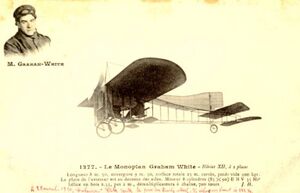Engineering:Blériot XII
| Blériot XII | |
|---|---|

| |
| Role | |
| Manufacturer | Louis Blériot |
| Designer | Louis Blériot |
| First flight | 21 May 1909 |
| Number built | at least 3 |
The Blériot XII was an early French aeroplane built by Louis Blériot. It was first flown in May 1909 and was the first aircraft to be flown with two passengers on board, and was used by Blériot to gain second place in the 1909 Gordon Bennett Cup and to set a new world speed record.
Development
The Blériot XII was a high wing tractor configuration monoplane with a deep uncovered fuselage, with the wings mounted on the upper longerons and the pilot and passenger seated between upper and lower longerons below the trailing edge of the wing. Lateral control was effected by a pair of ailerons mounted independently of the wings on the lower longerons behind the pilot. The prototype was initially powered by an 40 hp (30 kW) E.N.V. Type D water-cooled engine mounted on the lower longerons, driving a two-bladed propeller mounted at the same level as the wing via a chain with a reduction ratio of about 2:1. When first flown the empennage consisted of an elevator at the extreme rear of the fuselage, with a separate fixed horizontal surface mounted above and in front of it, and three small rectangular rudders above the elevator.[1] After initial flight trials during May 1909 the rudders were removed. Various configurations were experimented with, the final arrangement being an elongated triangular fin with a rectangular unbalanced rudder hinged to the trailing edge.
Operational history
The aircraft was first flown by Blériot on 21 May. Over the following weeks he made a number of long flights, and on 12 June it became the first aircraft to fly with three people aboard. One of the passengers was Alberto Santos-Dumont.[2] At the Grande Semaine d'Aviation held at Reims between August 22 and August 29 Blériot flew two Type XIIs, the prototype (now powered by a 60 hp (45 kW) E.N.V. Type F and another powered by a 40 hp (30 kW) Anzani. Flying the E.N.V. powered aircraft he came second in the Gordon Bennett Cup race on 28 August, being beaten by Glenn Curtiss by a margin of 6 seconds. Later that day he succeeded in winning the prize for the fastest lap of the 10 km (6.2 mi) circuit, with a time of 7 minutes 47.8 seconds. His speed of 77 kilometres per hour (48 mph) was a new world speed record for the distance.[3] The next day Blériot was flying the aircraft at a low altitude when it stalled, crashed and burst into flames. Blériot managed to land the aircraft and get clear, rolling on the ground to put out his overalls, which had caught fire, but the aircraft was destroyed.
An example powered by a 60 horsepower (45 kW) E.N.V. Type F was bought in December 1909 by Claude Grahame-White,[4] who named it the White Eagle. However, Grahame White found the aircraft unsatisfactory, and it was later sold to Colonel Joseph Laycock and the Duke of Westminster, who presented it to the British War Office, making it the first heavier-than-air craft possessed by the Balloon School.[5] Lieutenant Reginald Cammell was sent to France to collect the aircraft. Cammell described the aircraft as dangerously unstable and having too steep a glide angle. At Larkhill it acquired the nickname "The Man-Killer", and was eventually rebuilt by the Royal Aircraft Factory, who transformed it into the S.E. 1.[6]
Specifications
Data from Opdycke 1999 p.55
General characteristics
- Crew: 1
- Capacity: 2
- Length: 9.5 m (31 ft 2 in)
- Wingspan: 10 m (32 ft 10 in)
- Wing area: 22 m2 (240 sq ft)
- Empty weight: 600 kg (1,323 lb)
- Powerplant: 1 × E.N.V. , 35 kW (47 hp)
Performance
- Maximum speed: 100 km/h (62 mph, 54 kn)
Notes
- ↑ Opdycke 1999 p.55
- ↑ Three Men in an AeroplaneFlight 19 June 1909
- ↑ Tabulated performances of Rheims MeetingFlight 4 September 1909
- ↑ Aviators and their Doings at PauFlight 18 December 1909
- ↑ Driver, Hugh The Birth of Military Aviation: Britain 1903-1914 Woodbridge, Boydell, 1997 p.257 ISBN:0-86193-234-X
- ↑ Lewis, P. British Aircraft 1809-1914 London: Putnam, 1962, p.423. Ironically, although the Blériot had not actually been involved in a fatal crash, the S.E.1 was destroyed in a crash which killed the pilot, Lt. T. J. Rudge
References
- Taylor M.J.H. Jane's Encyclopedia of Aviation London: Studio Editions, 1989 p. 161
- Devaux, Jean and Michel Marani. "Les Douze Premiers Aéroplanes de Louis Blériot". Pegase No 54, May 1989.
- Opdycke, L. French Aircraft Before the Great War Atglen, PA: Schiffer, 1999. ISBN:0-7643-0752-5
- Phillips, Brian A. Bleriot: Herald of an Age. Stroud: Tempus, 2000. ISBN:0-7524-1739-8
 |


